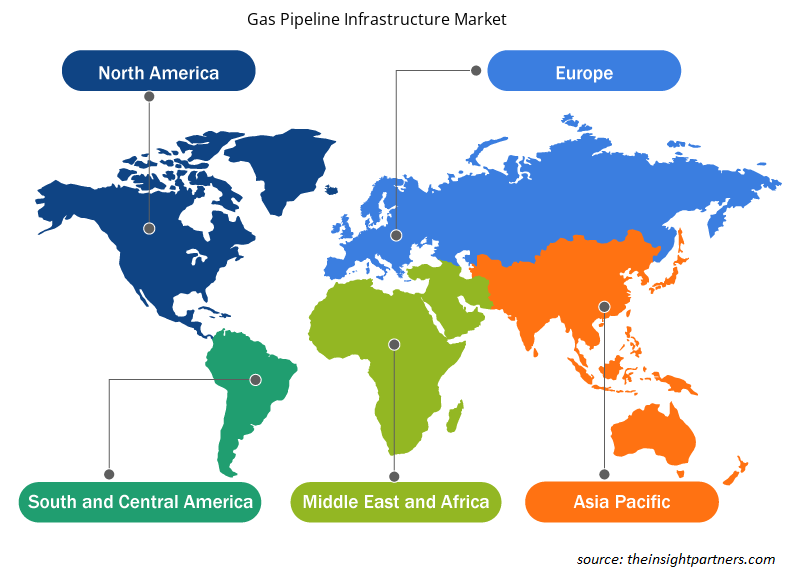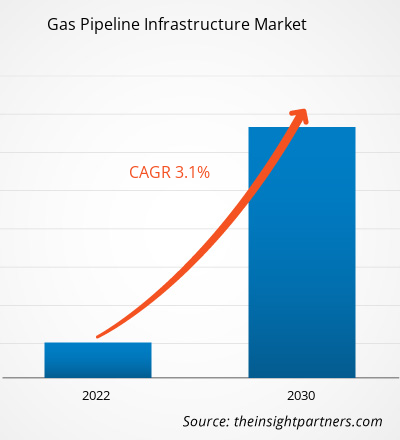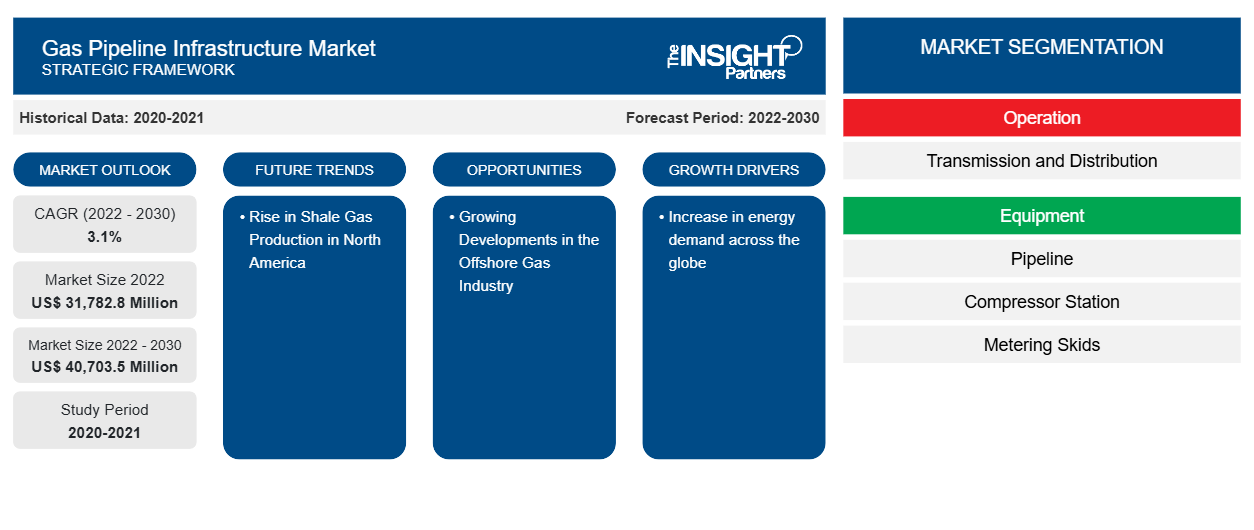Si prevede che la dimensione del mercato delle infrastrutture dei gasdotti raggiungerà i 40.703,5 milioni di dollari entro il 2030, rispetto ai 31.782,8 milioni di dollari del 2022. Si prevede che il mercato registrerà un CAGR del 3,1% nel 2022-2030.
Analisi del mercato delle infrastrutture dei gasdotti
Il mercato del gas naturale è altamente dinamico e richiede liquidità, flessibilità e trasparenza per funzionare efficacemente. Pertanto, sono necessarie più fonti di approvvigionamento, più utenti e un'infrastruttura completa per la trasmissione e la distribuzione. Il mercato del gas naturale è significativamente sviluppato negli Stati Uniti, in Europa e nell'Asia Pacifica, il che dovrebbe guidare la crescita dell'infrastruttura del gasdotto con l'aumento della domanda di gas in futuro.
Panoramica del mercato delle infrastrutture dei gasdotti
L'ecosistema infrastrutturale del gasdotto include la fase di produzione, in cui il gas naturale viene estratto da giacimenti sotterranei. Le società di esplorazione e produzione impiegano tecnologie di perforazione per estrarre gas naturale grezzo. Una volta estratto, il gas viene in genere elaborato per rimuovere le impurità e quindi compresso per il trasporto. La fase di produzione comporta considerazioni di fattori geologici, tecnologie di estrazione e valutazioni di impatto ambientale. I principali attori coinvolti nella produzione di gas naturale sono Royal Dutch Shell, ExxonMobil Corporation, Gazprom, ConocoPhillips e TotalEnergie. Gli attori chiave nella rete di trasmissione del gasdotto includono Kinder Morgan Inc., Enbridge Inc., TC Energy Corporation, Pembina Pipeline Corporation e Texas Gas Transmission LLC, tra gli altri.
Personalizza questo report in base alle tue esigenze
Riceverai la personalizzazione gratuita di qualsiasi report, comprese parti di questo report, o analisi a livello nazionale, pacchetto dati Excel, oltre a usufruire di grandi offerte e sconti per start-up e università
-
Scopri le principali tendenze di mercato in questo rapporto.Questo campione GRATUITO includerà analisi di dati che spaziano dalle tendenze di mercato alle stime e alle previsioni.
Driver e opportunità del mercato delle infrastrutture dei gasdotti
Si prevede che l'aumento della domanda di energia in tutto il mondo sarà il principale motore del mercato delle infrastrutture dei gasdotti
La popolazione in crescita e la crescente urbanizzazione sono alcuni fattori che aumentano il consumo di energia in tutto il mondo. Il gas naturale ha un potenziale di applicazione nella generazione di elettricità, il che ne aumenta la domanda. Inoltre, a causa delle crescenti incertezze energetiche in Europa dovute alla guerra tra Russia e Ucraina, i governi di diversi paesi stanno anche aumentando l'applicazione del gas naturale. Pertanto, l'aumento della domanda di energia alimenta la crescita del mercato delle infrastrutture dei gasdotti
Aumento della produzione di gas di scisto in Nord America
Il Nord America si è assicurato la sua posizione come uno dei principali produttori di gas di scisto al mondo. Il Canada è il quinto produttore e il quarto esportatore di gas naturale al mondo. I principali giacimenti di gas di scisto canadesi includono l'Horn River Basin e gli scisti di Montney nel nord-est della British Columbia, l'Utica Shale del Quebec, il Colorado Group di Alberta e Saskatchewan e l'Horton Bluff Shale del New Brunswick e della Nuova Scozia. Le incertezze energetiche dovute a disordini geopolitici stanno aumentando la produzione di gas di scisto nel Nord America, il che probabilmente creerà grandi opportunità per la crescita del mercato delle infrastrutture dei gasdotti nei prossimi anni.
Analisi della segmentazione del rapporto di mercato sulle infrastrutture dei gasdotti
I segmenti chiave che hanno contribuito alla derivazione dell'analisi di mercato delle infrastrutture del gasdotto sono la gestione, le attrezzature e l'applicazione.
- In base all'operazione, il mercato delle infrastrutture dei gasdotti è stato suddiviso in trasmissione e distribuzione. Il segmento della distribuzione ha detenuto una quota di mercato maggiore nel 2022.
- In termini di attrezzature, il mercato è stato segmentato in condotte, stazioni di compressione, skid di misurazione e altri. Il segmento delle condotte ha dominato il mercato nel 2022.
- In termini di applicazione, il mercato è stato segmentato in onshore e offshore. Il segmento onshore ha dominato il mercato nel 2022.
Analisi della quota di mercato delle infrastrutture dei gasdotti per area geografica
L'ambito geografico del rapporto sul mercato delle infrastrutture dei gasdotti è suddiviso principalmente in cinque regioni: Nord America, Europa, Asia Pacifico, Medio Oriente e Africa e Sud America.
Il Nord America è uno dei principali esportatori di gas. La crescente domanda di energia e la crescente applicazione del gas naturale stanno stimolando lo sviluppo del mercato delle infrastrutture dei gasdotti nel Nord America. Nel 2022, gli Stati Uniti hanno mostrato la più alta capacità di produzione di gas naturale, seguiti da Canada e Messico. Ixachi, Coulomb Phase 2, Quesqui, Nejo (IEPC), Leo, May, Koban e Powerball sono alcuni dei campi di produzione di gas naturale nel Nord America. L'impianto di Ixachi si trova a Veracruz, in Messico, e ha prodotto 618,09 mmcfd (milioni di piedi cubi al giorno) nel 2022. Inoltre, si prevede che il crescente numero di iniziative governative e finanziamenti per lo sviluppo delle infrastrutture dei gasdotti stimolerà il mercato delle infrastrutture dei gasdotti nel periodo di previsione.
Approfondimenti regionali sul mercato delle infrastrutture dei gasdotti
Le tendenze regionali e i fattori che influenzano il mercato delle infrastrutture dei gasdotti durante il periodo di previsione sono stati ampiamente spiegati dagli analisti di Insight Partners. Questa sezione discute anche i segmenti e la geografia del mercato delle infrastrutture dei gasdotti in Nord America, Europa, Asia Pacifico, Medio Oriente e Africa e America meridionale e centrale.

- Ottieni i dati specifici regionali per il mercato delle infrastrutture dei gasdotti
Ambito del rapporto sul mercato delle infrastrutture dei gasdotti
| Attributo del report | Dettagli |
|---|---|
| Dimensioni del mercato nel 2022 | 31.782,8 milioni di dollari USA |
| Dimensioni del mercato entro il 2030 | 40.703,5 milioni di dollari USA |
| CAGR globale (2022-2030) | 3,1% |
| Dati storici | 2020-2021 |
| Periodo di previsione | 2022-2030 |
| Segmenti coperti |
Per operazione
|
| Regioni e Paesi coperti |
America del Nord
|
| Leader di mercato e profili aziendali chiave |
|
Densità degli attori del mercato delle infrastrutture dei gasdotti: comprendere il suo impatto sulle dinamiche aziendali
Il mercato delle infrastrutture per gasdotti sta crescendo rapidamente, spinto dalla crescente domanda degli utenti finali dovuta a fattori quali l'evoluzione delle preferenze dei consumatori, i progressi tecnologici e una maggiore consapevolezza dei vantaggi del prodotto. Con l'aumento della domanda, le aziende stanno ampliando le loro offerte, innovando per soddisfare le esigenze dei consumatori e capitalizzando sulle tendenze emergenti, il che alimenta ulteriormente la crescita del mercato.
La densità degli operatori di mercato si riferisce alla distribuzione di aziende o società che operano in un particolare mercato o settore. Indica quanti concorrenti (operatori di mercato) sono presenti in un dato spazio di mercato in relazione alle sue dimensioni o al valore di mercato totale.
Le principali aziende che operano nel mercato delle infrastrutture dei gasdotti sono:
- Enbridge Inc
- Kinder Morgan Inc
- Società energetica TC
- Società di oleodotti Pembina
- Gruppo Sinopec
- Infrastruttura di condotte limitata
Disclaimer : le aziende elencate sopra non sono classificate secondo un ordine particolare.

- Ottieni una panoramica dei principali attori del mercato delle infrastrutture dei gasdotti
Notizie di mercato e sviluppi recenti sulle infrastrutture dei gasdotti
Il mercato delle infrastrutture dei gasdotti viene valutato raccogliendo dati qualitativi e quantitativi dopo la ricerca primaria e secondaria, che include importanti pubblicazioni aziendali, dati associativi e database. Di seguito è riportato un elenco degli sviluppi nel mercato per il mercato e le strategie dei mercati delle infrastrutture dei gasdotti:
- Nel febbraio 2023, Enagas SA ha firmato un accordo con Reganosa in cui Enagas ha pagato 58,14 milioni di dollari USA a Reganosa per l'acquisto di una rete di 130 km di gasdotti di gas naturale. L'efficiente funzionamento e la sicurezza dell'approvvigionamento del mercato del gas iberico dipendono da questa rete. (Fonte: Enagas SA, comunicato stampa/sito Web aziendale/newsletter)
- Ad agosto 2022, TC Energy Corp e la CFE, la società elettrica statale del Messico, hanno stipulato un accordo strategico con l'obiettivo di accelerare lo sviluppo delle infrastrutture del gas naturale nelle zone centrali e sudorientali del paese. In relazione alle attività del gasdotto del gas naturale nel Messico centrale, TC Energy e la CFE hanno deciso di unire i precedenti accordi take-or-pay (TSA) sottoscritti dalla sussidiaria messicana di TC Energy TGNH e dalla CFE in un unico accordo take-or-pay con un prezzo in dollari USA che durerebbe fino al 2055. Anche i nuovi progetti infrastrutturali correlati pianificati in collaborazione con la CFE saranno disciplinati da questo nuovo TSA. (Fonte: TC Energy, comunicato stampa/sito Web aziendale/newsletter)
Copertura e risultati del rapporto sul mercato delle infrastrutture dei gasdotti
Il rapporto "Dimensioni e previsioni del mercato delle infrastrutture dei gasdotti (2020-2030)" fornisce un'analisi dettagliata del mercato che copre le seguenti aree:
- Dimensioni e previsioni del mercato a livello globale, regionale e nazionale per tutti i segmenti di mercato chiave coperti dall'ambito
- Dinamiche di mercato come fattori trainanti, vincoli e opportunità chiave
- Principali tendenze future
- Analisi PEST dettagliata
- Analisi di mercato globale e regionale che copre le principali tendenze di mercato, i principali attori, le normative e gli sviluppi recenti del mercato
- Analisi del panorama industriale e della concorrenza che copre la concentrazione del mercato, l'analisi della mappa di calore, i principali attori e gli sviluppi recenti
- Profili aziendali dettagliati con analisi SWOT
- Analisi storica (2 anni), anno base, previsione (7 anni) con CAGR
- Analisi PEST e SWOT
- Valore/volume delle dimensioni del mercato - Globale, Regionale, Nazionale
- Industria e panorama competitivo
- Set di dati Excel
Report recenti
Rapporti correlati
Testimonianze
Motivo dell'acquisto
- Processo decisionale informato
- Comprensione delle dinamiche di mercato
- Analisi competitiva
- Analisi dei clienti
- Previsioni di mercato
- Mitigazione del rischio
- Pianificazione strategica
- Giustificazione degli investimenti
- Identificazione dei mercati emergenti
- Miglioramento delle strategie di marketing
- Aumento dell'efficienza operativa
- Allineamento alle tendenze normative























 Ottieni un campione gratuito per - Mercato delle infrastrutture dei gasdotti
Ottieni un campione gratuito per - Mercato delle infrastrutture dei gasdotti